The old story goes that during the tumultuous days of fighting between rival branches of the English ruling Plantagenet family, courtiers wanting to make their loyalties known wore a white rose if they favored Richard of York, a red one if they supported the Lancastrian Henry. For nearly 500 years since, the struggle for the throne known as the Wars of the Roses has riveted the attention of historians—and novelists.
Of particular interest have been the rival ladies. Warning: unimaginative Plantagenet parents seemed to name all their sons Richard, Henry, or Edward and all their daughters Elizabeth or Margaret. Before beginning a read-a-thon, you might want to check Wikipedia or invest in a guide to the period. Novelist Alison Weir offers the non-fiction guide, THE WARS OF THE ROSES. New York Times bestselling Queen of Tudor fiction Philippa Gregory collaborated with historians David Baldwin and Michael Jones to produce THE WOMEN OF THE COUSINS’ WAR, which gives the background on the ladies featured in her Cousins’ War series. (more on her novels later.)
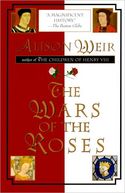 WARS OF THE ROSES |
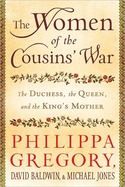 THE WOMEN OF THE COUSINS’ WAR |
Using a basically chronological approach, I begin with CROWN IN CANDLELIGHT by Rosemary Hawley Jarman, which features Katherine of Valois. Daughter of madman King Charles V of France, she was married off to Lancastrian Henry V of England, who became the hero of Agincourt, the great English victory over the French during the Hundred Year’s War. Widowed young, Katherine fell in love with her Welsh bard, Owen Tudor. To the scandal of everyone, the two married; their descendents would later claim the throne of England.
QUEEN OF LAST HOPES: THE STORY OF MARGARET OF ANJOU by Susan Higginbotham, narrates the tale of Henry VI and his French wife Marguerite. Henry, who suffered from bouts of madness (perhaps inherited from his French grandfather Charles V,) was challenged by his cousin Richard, Duke of York, who considered himself to have an equally legitimate claim to the throne. Despite her husband’s incapacity, Marguerite fought and schemed to save the throne for him and for their son.
QUEEN BY RIGHT by Anne Easter Smith, tells the story from the other side when she focuses on Cecily Neville, who married Richard, Duke of York. Theirs was a true love match, and through years of war, exile and danger, Cecily remained true to her Richard.
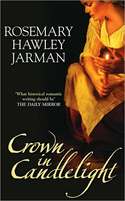 CROWN IN CANDLELIGHT |
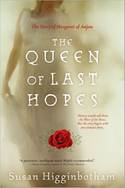 QUEEN OF LAST HOPES |
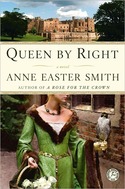 QUEEN BY RIGHT |
Hopping back on the Lancastrian side, we have LADY OF THE ROSES by Sandra Worth. Her heroine, Isobel Ingoldesthorpe, was the ward of Queen Marguerite. In true Romeo-and-Juliet fashion, Isobel fell in love with John Neville, Lord Montagu, Yorkist brother of the Earl of Warwick. Known as the Kingmaker for his power-brokering during the struggle between Henry VI (Marguerite’s husband) and Richard, Duke of York, and later Richard’s son who became Edward IV, Warwick demanded the loyalty of John and Isobel. Unlikely allies, through war and ever-shifting alliances, Isobel and John hold fast to their one true love—each other.
A truly epic figure is featured in historical fiction superstar Philippa Gregory‘s THE LADY OF THE RIVERS. Jacquetta of Luxembourg married the much-older Duke of Bedford, the uncle of Henry VI (Maguerite‘s husband; Lancastrian.) After his death, she scandalized the court by marrying one of his knights, Sir Richard Woodville, later Lord Rivers. The famed beauty of their widowed daughter Elizabeth Woodville (with, critics say, the aid of her mother’s witchcraft) caught the eye of Edward IV (Richard of York‘s son.) Knowing the union of a king and a mere knight’s daughter was impolitic, he married her in secret. But wars between Lancaster and York weren’t over yet, and at times, Edward IV had to flee for his life. Through it all, Jacquetta, aunt of a Lancastrian king, mother-in-law of Yorkist one, schemed to maintain her place at court, and her daughter and grandsons’ right to the throne.
A novel featuring Elizabeth Woodville herself is THE KING’S GREY MARE by Rosemary Hawley Jarman. Jarman presents Elizabeth (the “grey mare” a term of affection conferred because of her white-gold hair) as a conflicted figure who, after losing her beloved first husband in battle, joins forces with her mother to use trickery and witchcraft to enchant a king and gain power for her family. Her story is entwined with that of Grace, Edward IV’s illegitimate daughter, who worshipped the coolly distant Elizabeth but fell in love with the queen’s greatest enemy.
Philippa Gregory also presents a portrait of Elizabeth Woodville in THE WHITE QUEEN. Gregory’s Elizabeth is beautiful and ambitious, willing to ensnare a king in an unequal marriage and scheme to bring her family to power. But she is also the tragic mother of the Princes of the Tower. Her two sons, after Edward‘s premature death, stood to inherit the throne. Moved to the Tower of London for “protection” while their uncle, Edward’s brother Richard, ruled as guardian, the two princes disappeared, their fate still unknown today. But even before their disappearance, a court declared that, because their father Edward IV had contracted a prior alliance, they were illegitimate and therefore could not inherit—propelling their uncle to the throne as Shakespeare’s evil Richard III.
STOLEN CROWN: THE SECRET MARRIAGE THAT FOREVER CHANGED THE FATE OF ENGLAND by Susan Higginbotham, also tells Elizabeth Woodville‘s story, but from the perspective of her younger sister Katherine Woodville. She married Henry Stafford, Duke of Buckingham, who was first Richard III‘s ally, then his betrayer, and might be implicated in the death of the Princes of the Tower. Through the turmoil of shifting allegiances, Katherine tried to protect her love and her family.
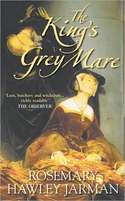 THE KING’S GREY MARE about Elizabeth Woodville |
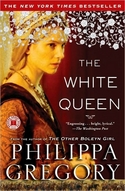 THE WHITE QUEEN about Elizabeth Woodville |
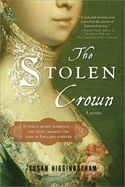 STOLEN CROWN about Elizabeth Woodville |
Another perspective on Edward‘s kingship is offered in DAUGHTER OF YORK by Anne Easter Smith. This story features Edward IV’s sister Margaret, who was married off in a political alliance to Charles, Duke of Burgandy—even though she lost her heart to Queen Elizabeth’s brother, Anthony Woodville. As the Wars of the Roses raged in England, Margaret had to steer a difficult course in France, trying to ensure the safety of her love and her family.
Our final installment today jumps back to the Lancastrian side with Philippa Gregory‘s THE RED QUEEN. This tells the story of Margaret Beauford, an heiress whose family favored the Lancastrians, who was married off at age 12 to Edmund Tudor. After her husband died, she threw all her energy into helping his posthumous son Henry manipulate royal intrigue to become the warrior who, at the Battle of Bosworth, defeated Richard III. Becoming king as Henry VII, he married Edward IV‘s daughter, Elizabeth of York, finally ending the Wars of the Roses.
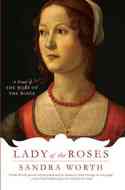 LADY OF THE ROSES |
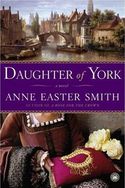 DAUGHTER OF YORK |
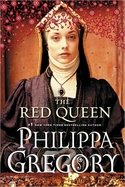 THE RED QUEEN |
Had enough Margarets, Elizabeths, Henrys and Richards?
I’ll continue the saga next month with stories about Richard III and his niece, Elizabeth of York, grandmother of Henry VII, the lady who united Lancaster and York.
Julia Justiss is the author of several historical romances including her latest, SOCIETY’S MOST DISREPUTABLE GENTLEMAN


No Comments
Comments are closed.